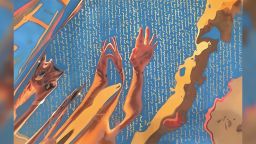Hunter Biden has been many things over his 51 years. But, in the last few years at least, he has been an artist.
“For years I wouldn’t call myself an artist,” he told The New York Times, from his Los Angeles home and studio, last year. “Now I feel comfortable saying it.”
Hunter’s art has, of late, received a lot of attention – for all the wrong reasons. Some of his pieces are set to go up for auction and the White House has been forced to deal with ethics questions about people buying the artwork for huge sums as a way to curry favor with President Joe Biden. Two sources familiar with the sales arrangement told CNN that buyers will be anonymous and Hunter Biden will never have any knowledge on who even bid on his pieces.
Ethics questions aside though, I was interested in something different: Is Hunter Biden’s art, well, any good? So I reached out to Sebastian Smee, the Pulitzer Prize-winning art critic for The Washington Post, to get his evaluation of Hunter Biden, artist.
Our conversation, conducted via email and lightly edited for flow, is below. (And you can check out some of Biden’s work here, here, here, and a fuller gallery here.)
Cillizza: Let’s start simple: Is Hunter Biden’s work any good, aesthetically speaking?
Smee: For me, not really.
I’ve only seen it in reproduction, so I’m sure I’m missing a lot: texture, layering, detail. Parts of them look technically impressive. But the style is eclectic in a way that makes his work feel neither one thing nor another.
Most great artists, whatever style of art they make, have been trying to make art all their lives. They are fully devoted to what they do. To me, Biden seems a bit of a dabbler.
His work has the feeling of an afterthought. It doesn’t feel like it needed to be made, except perhaps as a therapeutic exercise. I have no trouble with that. It’s as good a reason to make art as any. But if I were a museum curator, I would struggle to find compelling reasons to share it with the public.
Cillizza: How has the art world reacted to Hunter Biden the artist – particularly given that he has no formal training as such?
Smee: Mostly, a shoulder shrug. A few people probably sniff the chance to make money from his notoriety. But for the most part, people with influence in the art world are looking at his work and thinking, “Nothing much to see here.”

That’s because there is a lot of art out there that looks a bit like Biden’s. Abstract, pretty, well-made. But also a bit overloaded with ideas that aren’t well integrated into the work itself. Would you call this kind of art a genre? I don’t know. But if it is, the examples of his I’m seeing online don’t particularly stand out.
The fact that he has no formal training is not an issue. Plenty of artists have achieved great things with no formal training. Formal training can count for a lot: One of the hardest things in the world is to paint like Van Eyck or Velazquez or Vermeer. What the Old Masters did after years of training remains awe-inspiring.
But tastes and technologies change, and we are by now used to the idea that formal training can sometimes be an impediment, something to overcome or work through on the way to arriving at a singular and original vision. We have seen that happen again and again in the most powerful art of the past 150 years. Picasso is an obvious example.
The issue with Biden’s work is more just that it’s kind of pleasant. The colors are pretty, the patterns are nice, but it has no real urgency, no underlying poetry. There is none of the sense you get from great art (think Vincent Van Gogh, Jackson Pollock, or Frida Kahlo) of a powerful personality being concentrated and funneled through the painting you’re looking at.
Cillizza: The New York Times last year described Biden’s paintings as “leaning toward the surreal.” Is that how you would describe them? Why or why not?
Smee: People sometimes say “surreal” when they mean random.
From what I’ve seen, Biden’s work is less surreal than decorative. Decorative is OK: Matisse was decorative. But Matisse was not random. You can feel the internal logic in every work he made, and from work to work throughout his career. In Biden’s case, I’m not feeling that at all.
Cillizza: In an interview earlier this year with Artnet, Hunter Biden said he paints “to bring forth, what is, I think, the universal truth.” What do you make of his work, seen through that light?
Smee Not trying to be unkind (no one is interested in my idea of universal truth either, as far as I know) but I’m not sure how interested I am at the moment in Hunter Biden’s idea of universal truth.
I mean, give me a break. What is he? A Bodhisattva? A guru? He may have figured out some stuff for himself, and that’s great. But if I’m searching for universal truths, there are other people I’ll go to first.
Cillizza: Finish this sentence: Hunter Biden’s work resembles the work of ____________.” Now, explain.
Smee: “… a cafe painter.”
By which I mean, you see a certain kind of art in coffee shops, and some of it is OK and a lot of it is bad, and sometimes it’s surprisingly good. But you wouldn’t, unless you were related to the artist, spend more than $1,000 on it.







